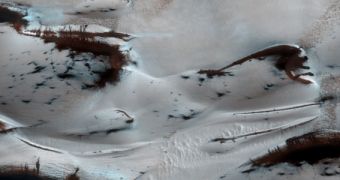The image above shows a collection of relatively-large sand dunes on Mars. According to NASA experts, these dunes are some of the northern-most on the Red Planet, meaning that they get covered in carbon dioxide ice, or dry ice, every single winter season. However, temperatures are currently rising as our neighboring world nears spring, and some of the ice is coming off.
This is clearly visible on the south-facing slopes of the dunes, which are now dark and barren. Due to their orientation, they are now able to soak up more light and heat from the Sun, so they can shed their dry ice covers sooner than the north-facing slopes. The steepest portions on these dunes are also ice-free, since they allow sand to move about freely.
All dark splotches seen in the image above are areas where dry ice covers have cracked earlier than usual, revealing the darker-colored sand underneath. Scientists estimate that all dunes in this region will be completely free of ice within the next few months, concealing any signs heralding the arrival of the Martian spring.
The photo was collected on January 16, 2014, by the High Resolution Science Imaging Experiment (HiRISE) instrument aboard the NASA Mars Reconnaissance Orbiter (MRO). HiRISE is operated by a team of experts at the University of Arizona in Tucson. The MRO is managed for NASA Headquarters by the Jet Propulsion Laboratory in Pasadena, California.

 14 DAY TRIAL //
14 DAY TRIAL //